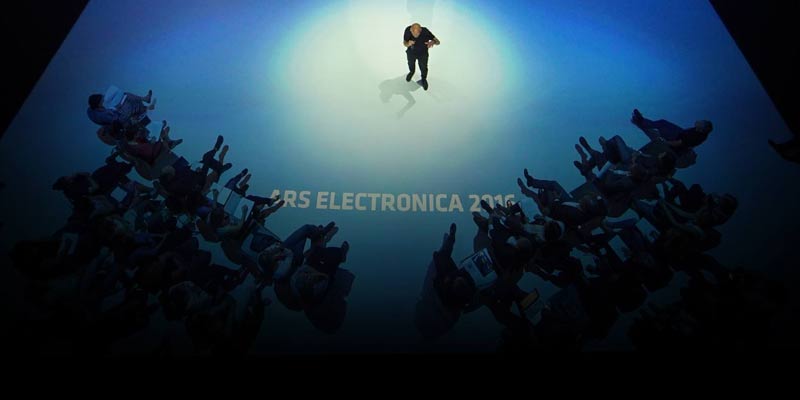Ars Electronica Center
Deep Space Weekend: The Gigantic Machines of Science
Saturday & Sunday, March 4-5, 2017
Press Release: Deep Space Weekend: The Gigantic Machines of Science
(Linz, March 1, 2017) This coming Saturday and Sunday, March 4-5, the Ars Electronica Center is dedicating an entire weekend to the gigantic machines of science. Visitors can look forward to fascinating speeches accompanied by spectacular images of CERN’s Large Hadron Collider, the IceCube Neutrino Observatory and the LIGO Gravitational-Wave Observatory. The next Deep Space LIVE on Thursday, March 2nd will kick things off with a presentation of the results of a terrestrial simulation of a Mars expedition.
Deep Space LIVE: Analog Research – Mars on the Earth
Thursday, March 2, 2017 / 7-8 PM
Austrian glaciers and the Northern Sahara served researchers as proving grounds for a simulated Mars expedition. Gernot Grömer of the Austrian Space Forum will discuss the experiments the project staff conducted and the results they gleaned.
Here’s an overview of the Deep Space Weekend lineup:
THE BIG BANG MACHINE: IN SEARCH OF THE BEGINNING OF THE WORLD
Saturday, March 4th / 3-4 PM
The Large Hadron Collider (LHC), the “largest machine of all time,” was placed in service in Geneva in autumn 2009. Inside it, subatomic particles collide at almost the speed of light. Researchers hope it will help them understand the Big Bang and, thus, how the universe came into being. German astronomer and author Dieter B. Hermann’s speech will elaborate on outer space and the microcosm, and explain how experiments done with the LHC are changing and expanding our view of the world and the universe.
THE WORLD’S LARGEST EYE – THE EUROPEAN EXTREMELY LARGE TELESCOPE AT THE ESO
Saturday, March 4th / 5-6 PM
In 2014, the European Southern Observatory (ESO) began preparations for the construction of the European Extremely Large Telescope (E-ELT) that, upon completion, will be the world’s largest astronomical telescope. Its main mirror, with a diameter of 39 meters, is predicted to deliver images 15 times clearer than those from the Hubble Space Telescope. Peter Habison of the ESO Science Outreach Network Austria will talk about the construction of the E-ELT and current astronomical research at the ESO.
THE ICECUBE NEUTRINO OBSERVATORY AND THE LIGO GRAVITATIONAL-WAVE OBSERVATORY
Sunday, March 5th / 1-2 PM
Neutrinos and gravitational waves will be the subject of a speech by Erich Meyer of the Linz Astronomical Society. Neutrinos are electrically neutral particles that pervade everything on Earth by the second and by the billion. They’re tracked by the huge IceCube Neutrino Observatory at the South Pole. Erich Meyer will also explain what gravitational waves are all about and why the big expenditure of effort to detect them.
CERN – ACCELERATING SCIENCE
Sunday, March 5th / 3-4 PM
Andreas Bauer, museum director at the Ars Electronica Center, will present the series of world records that CERN’s Large Hadron Collider has set. He’ll also describe the special spirit that pervades CERN, where scientists from throughout the world peacefully collaborate.
In addition to the gigantic machines of science, there are some fun activities on tap during Deep Space Weekend:
ASTRONOMY FOR FAMILIES
Saturday & Sunday, March 3-4 / 10:30-11 AM both days
Running in Deep Space 8K is Uniview, state-of-the-art visualization software that lets viewers take an interactive 3-D journey through the entire known universe. Modeled depictions bring heavenly bodies so close you could almost reach out and touch them—the planets that are our neighbors in the Solar System as well as distant galaxies. Uniview also delivers spectacular visualizations of additional information—for instance, data about planets’ orbits or the Earth’s magnetic field.
QUADRATURE – ORBITS
Saturday March 4th, 12:30-1 PM and Sunday, March 5th, 5:30-6 PM
Quadrature is an audiovisual performance in Deep Space 8K based on real-time measurements of the movements of satellites and space junk—a total of 15,000 objects. The results are floral, organic patterns that are magnificent to behold but nevertheless stem from the cast-off waste products of our civilization.
http://www.flickr.com/photos/arselectronica/32322322876/
The European Extremely Large Telescope / credit: ESO / Printversion
http://www.flickr.com/photos/arselectronica/5679904557/
Aerial view of the CERN / credit: CERN, Maximilien Brice / Printversion
http://www.flickr.com/photos/arselectronica/5680466430/
The LHC tunnel / credit: CERN, Maximilien Brice / Printversion
http://www.flickr.com/photos/arselectronica/29609593795/
Quadrature / credit: tom mesic / Printversion
http://www.flickr.com/photos/arselectronica/33038287471/
Uniview / credit: Ars Electronica, Christopher Sonnleitner / Printversion

